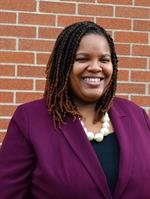Courtney Bradford has a passion for African American history. Among the first items Bradford brought into her new office at the Mosaic Templars Cultural Center were family photos, statues of Buffalo soldiers that travel with her everywhere and a wooden Sankofa bird from Africa.
“You must know your history to move forward,” Bradford said. That’s one reason history is so fascinating – it reveals people’s collective and individual identities, she said. “African American history is truly my passion.”
Bradford, the new curator at MTCC, is using the past to cultivate new ideas for exhibitions, artifacts and ways of reaching audiences. On a recent Wednesday afternoon, she laid old photos and newspapers on her desk and delicately accessioned them.At the same time, on her computer screen, Bradford was reviewing information about stained glass from a 1904 African American church in Arkansas.
Bradford, 31, grew up in Little Rock, where her family held prominent positions as educators or business owners. Her grandfather, Frederick W. Carter, Sr. is in the Dunbar Traveling Exhibit available through MTCC. The Paul Laurence Dunbar High School was a school for African American boys and girls in Little Rock from 1929 to 1955.
After graduating with a bachelor’s degree in Anthropology,African and African American Studies from the University of Arkansas at Fayetteville, Bradford went on to earn a master’s degree in Public History from the University of Arkansas at Little Rock in 2014. She has worked as an interpreter for the Historic Arkansas Museum, and most recently taught at UA Pulaski Technical College. But, her dream job had long been to be the curator for an African American museum, so she jumped at the chance to apply to MTCC.
“I’m very excited to be here,” Bradford said. “It’s like a dream come true.”
Bradford replaces curator Bryan McDade, who left the position in October to pursue a master’s degree in seminary studies. Bradford started at MTCC on Nov. 2, right as the museum started planning to unveil major 2021 programs, events, exhibits and initiatives.
Despite the bustle, Bradford has her own goals, too. She wants to expand MTCC’s permanent collections, including adding artifacts from African American community churches. Mount Pleasant Missionary Baptist Church, among the first Black churches in Arkansas, has its own museum, she said. The church, established in Little Rock in 1875, might be willing to partner with MTCC or donate artifacts, she said. Churches have long been epicenters of African American life, history, culture and survival, Bradford said.Any artifacts Bradford collects from churches could end up in an exhibition, Bradford said.
Separately, Bradford is working on collecting artifacts, documents and stories for“Covid in Black: The African American Experience in Arkansas.” The program is a MTCC-led initiative to preserve and showcase the experiences and stories of African American life in Arkansas during the pandemic.
COVID-19 has hit Black communities harder than white communities nationwide, according to the Centers for Disease Control and Prevention. Plus, the experiences and voices of African Americans often have been left out of history. Bradford hopes to preserve what is happening now for future generations and create a safe space that showcases what African Americans are seeing, hearing and feeling.The exhibit could be opened as early as 2022, she said.
Bradford plans to use technology to reach new audiences via virtual experiences by building a digital platform for Covid in Black. Submitted items, such as photos of children attending class via Zoom; people wearing masks during protests against police brutality and racial injustice; handmade masks from when masks were difficult to obtain; and videos of local people telling stories about themselves and their families, could be in the exhibit. The site, not yet up, is used by other museums to create virtual exhibitions, Bradford said. The idea would be to give people an alternative way to see the exhibition, Bradford said.
“I would like to see people’s real stories – people’s for-real experiences,” Bradford said.
Bradford, who has a 5-year-old son, said she wants history to be an educational tool for children and adults. Knowing history is vital to knowing your community, your family and yourself, she said.
As she spoke, Bradford picked up the Sankofa bird from her bookshelf and placed it on her desk. The bird, with its head turned backward and lowered toward its feathers, is from the Akan people of Ghana and symbolizes the importance of reaching back in time or back within yourself to bring past-gained knowledge to the present. Bradford said she picked up the sculpture during a life-changing study abroad experience.In the end, Bradford learned an enlightened past can allow people to know themselves enough to be able to make the decision to change, she said. She patted the sculpture.
“To go back and to get the knowledge that you need to move forward – that is the Sankofa way,” she said. “It keeps pushing us forward. It keeps pushing everything forward.”
